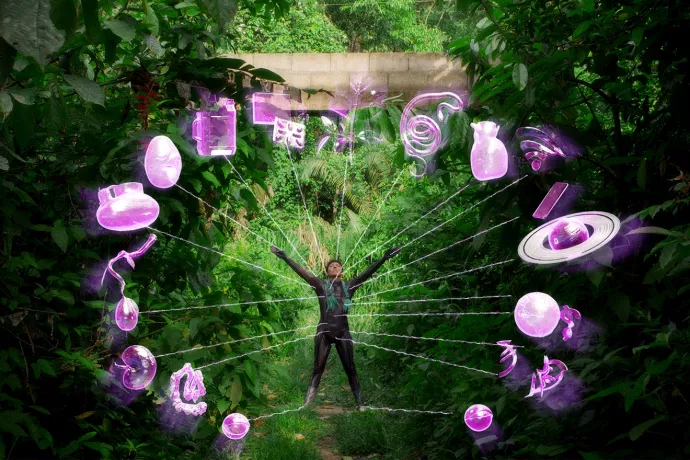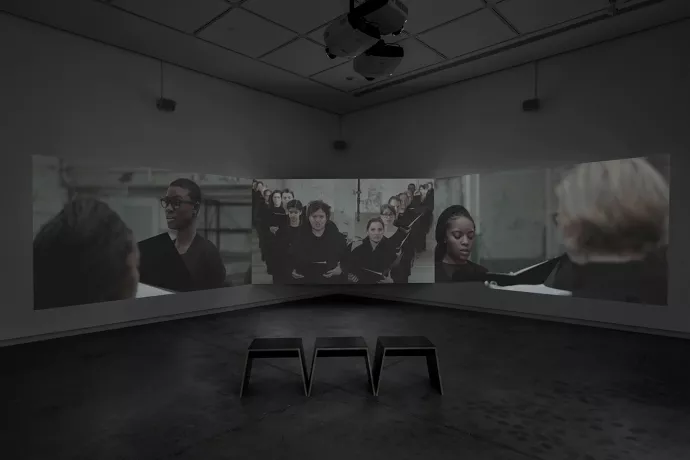
Newest Blackwood exhibition emphasizes transformation and healing
Content warning: GUT_BRAIN 1: Destructive Desires and Other Destinies of Excess is a two-part program at the Blackwood Gallery featuring gallery exhibitions, artwork in lightboxes and public spaces on campus, video screenings and performances. The exhibition continues with a new lightbox cycle opening on Oct. 25.
Ongoing world events are impacting many members of our community. While the theme of this exhibition is meant to highlight the journey from injury to healing, the visuals may provoke a wide range of responses.
For immediate counselling support – anytime – students can call U of T Telus Health at 1-844-451-9700. For faculty, staff and librarians, there’s the Employee and Family Assistance Program, also available 24 hours a day, seven days a week: 1-855-597-2110.
Blackwood Gallery curator and director Christine Shaw believes art has the power to elicit a range of feelings and perspectives, and then change the world.
“By staging exhibitions like (the upcoming) GUT_BRAIN 1, one of our goals is to promote interdisciplinary and intercultural dialogue with students, faculty and staff across campus,” she says.
GUT_BRAIN 1: Destructive Desires and Other Destinies of Excess, which opens Oct. 25, is a two-part program at the Blackwood Gallery featuring artwork in lightboxes and public spaces on campus, video screenings and performances.
Shaw is encouraging viewers to explore the images ahead of time on the gallery’s website, where they will find descriptions and curatorial statements, as well as related resources, including thematically linked publications and links to on-campus supports.
“(That) enables viewers to situate them within the broader exhibition and draw connections that may not otherwise emerge in a single encounter,” she says. “It nurtures practices of slow looking and reading images with care, while preparing viewers to critically engage with the artworks on campus.”
Advance familiarity with the images may also encourage passersby to take a closer look, she said – a change from the usual shallow bombardments in everyday life.
Adopting a trauma-informed approach to presentation, the Blackwood Gallery website and didactic panels accompanying each lightbox recommend viewing them with a friend for added security and comfort. They also provide a wide array of support systems and resource lists for community members should they need assistance or additional information.
Featuring the work of female Indigenous, Latinx and BIPOC artists, GUT_BRAIN 1 focuses on self-representation, depicting journeys from injury to potential, separation to symbiosis and damage to possible futures.
“We turn to artists because they have a unique capacity for picturing lived realities and imagining possible futures,” says Shaw. “As curators, we seek to bring it into dialogue with scholarship and activism happening at UTM.”

GUT_BRAIN 1 is being staged in six movements in sites between Mississauga, Ont. and Oaxaca, Mexico, with the program geography tracing the trajectory of the human digestive system. It is being co-curated with Blackwood’s Curatorial Research Fellow Irmgard Emmelhainz, a scholar based in Mexico City.
The presentation of the works helps interweave the stories, Shaw says.
“Each of the four curated images are to be read in dialogue with the other,” she explains. “An artwork is like a word within a sentence; by learning to read each artwork together, viewers are able to better understand the exhibition as a whole.”
The outdoor lightboxes will highlight content from the show. Each is positioned with consideration for its surroundings and visibility. For example, Regina José Galindo’s La Sombra will be exhibited on the exterior of the Kaneff Centre, the closest entrance to the Blackwood Gallery, where staff will be on hand to facilitate engagement and support.
“We are surrounded by and subjected to all kinds of images willingly or not, and often without context or support. The images we encounter on a daily basis on billboards, personal devices and screens in public space are often vested with commercial interests, corporate commands and propaganda,” says Shaw. “It is always our hope that (the lightbox images) elicit contemplation, curiosity and conversation.”
A piece that benefits from advance viewing is Anishinaabek artist Rebecca Belmore’s Fringe, which features a depiction of bodily harm, but also delicate mending of the body through beadwork, as a reminder of the power of cultural reclamation
“So it is a very simple scenario: she will get up and go on, but she will carry that mark with her. She will turn her back on the atrocities inflicted upon her body and find resilience in the future. The Indigenous female body is the politicized body, the historical body. It’s the body that doesn’t disappear,” said Belmore at a previous exhibition.
The intention of the collection is to emphasize the potential for transformation, healing, restoration and rematriation, says Shaw. “Engaging with contemporary art is not just a passive experience but a dynamic practice. We hope that our audiences will gain a deeper appreciation for the transformative potential of art as well as a renewed sense of empowerment and responsibility to engage with issues of social justice and equity.”
For more information, visit www.blackwoodgallery.ca.
Read more:
